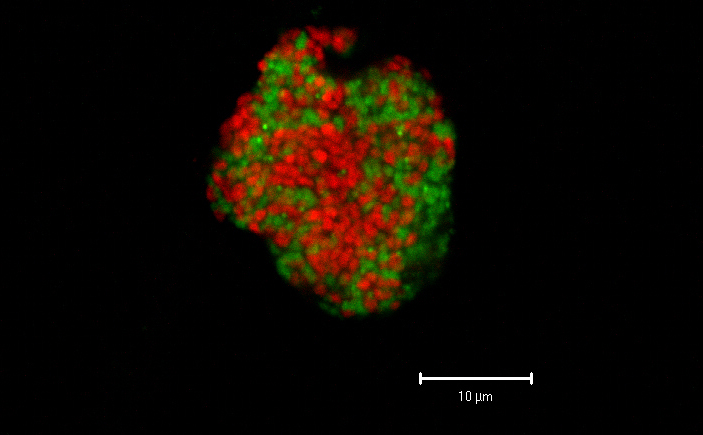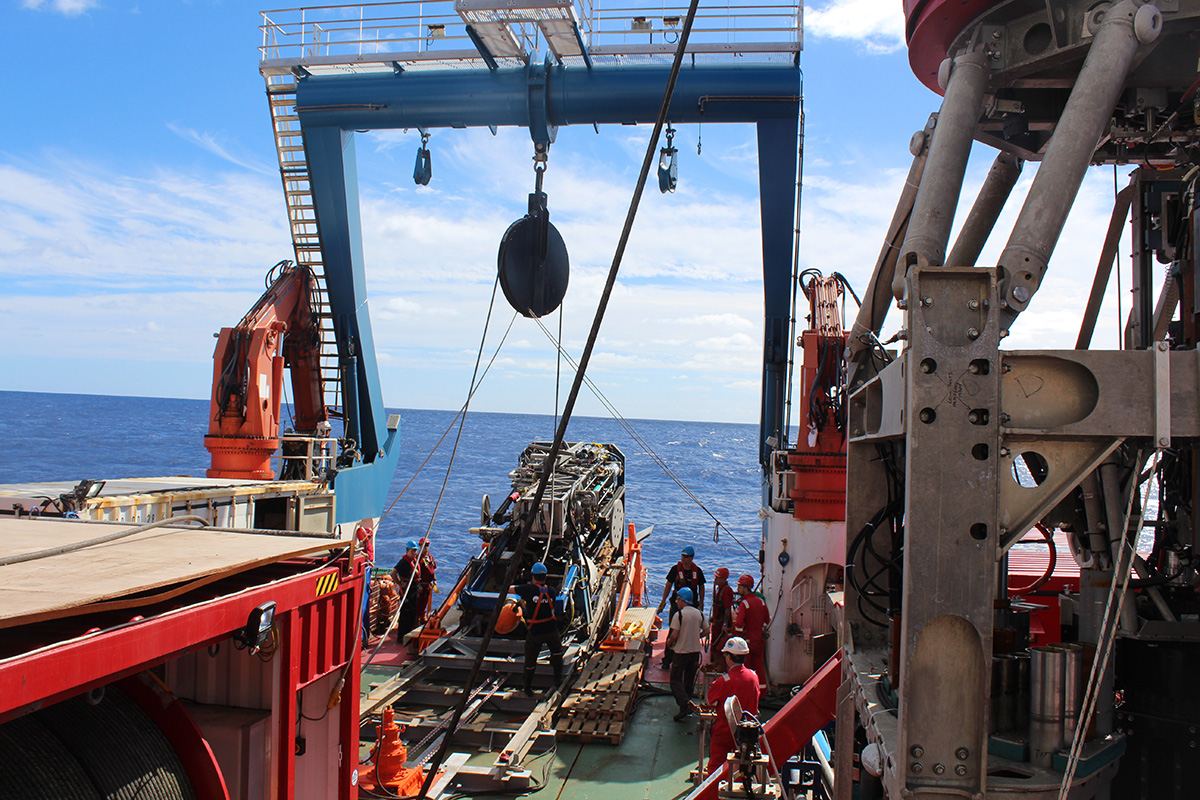Team Totals Immense Amount of Carbon in "Zombie" Bacteria, Other Deep Life Microbes

Deep Carbon Observatory contacts:
Terry Collins: tc@tca.tc;
Katie Pratt: katie_pratt@uri.edu
Barely living “zombie” bacteria and other forms of life constitute an immense amount of carbon deep within Earth’s subsurface—245 to 385 times greater than the carbon mass of all humans on the surface, according to scientists nearing the end of a 10-year international collaboration to reveal Earth’s innermost secrets.
At the American Geophysical Union’s annual meeting this week, scientists with the Deep Carbon Observatory are reporting on several transformational discoveries, including how much and what kinds of life exist in the deep subsurface under the greatest extremes of pressure, temperature, and low energy and nutrient availability.
Says Mitchell Sogin of the Marine Biological Laboratory Woods Hole, USA, co-chair of DCO’s Deep Life community of more than 300 researchers in 34 countries: “Exploring the deep subsurface is akin to exploring the Amazon rainforest. There is life everywhere, and everywhere there’s an awe-inspiring abundance of unexpected and unusual organisms.
Drilling 2.5 kilometers into the seafloor, and sampling microbes from continental mines and boreholes more than 5 km deep, the team has used the results to construct models of the ecosystem deep within the planet.
 Cells in this cluster of archaea (ANME-2 cells, red) and bacteria (Desulfosarcina / Desulfococcus species, green) work together to harvest energy from methane at seafloor seeps. These organisms have very slow growth rates with a minimum doubling time of a few months, making them very difficult to cultivate and study in the lab. Image courtesy Katrin Knittel (MPI Bremen)
Cells in this cluster of archaea (ANME-2 cells, red) and bacteria (Desulfosarcina / Desulfococcus species, green) work together to harvest energy from methane at seafloor seeps. These organisms have very slow growth rates with a minimum doubling time of a few months, making them very difficult to cultivate and study in the lab. Image courtesy Katrin Knittel (MPI Bremen)“Molecular studies raise the likelihood that microbial dark matter is much more diverse than what we currently know it to be, and the deepest branching lineages challenge the three-domain concept introduced by Carl Woese in 1977,” Sogin said. “Perhaps we are approaching a nexus where the earliest possible branching patterns might be accessible through deep life investigation.”
With insights from now hundreds of sites under the continents and seas, they have approximated the size of the deep biosphere—2 to 2.3 billion cubic km (almost twice the volume of all oceans)—as well as the carbon mass of deep life: 15 to 23[1] billion tonnes.
The work also helps determine types of extraterrestrial environments that could support life.
Among many key discoveries and insights:
- The deep biosphere constitutes a world that can be viewed as a sort of “subterranean Galapagos” and includes members of all three domains of life: bacteria and archaea (microbes with no membrane-bound nucleus), and eukarya (microbes or multicellular organisms with cells that contain a nucleus as well as membrane-bound organelles)
- Two types of microbes—bacteria and archaea—dominate Deep Earth. Among them are millions of distinct types, most yet to be discovered or characterized. This so-called microbial “dark matter” dramatically expands our perspective on the tree of life. Deep Life scientists say about 70% of Earth's bacteria and archaea live in the subsurface
- Deep microbes are often very different from their surface cousins, with life cycles on near-geologic timescales, dining in some cases on nothing more than energy from rocks
- The genetic diversity of life below the surface is comparable to or exceeds that above the surface
- While subsurface microbial communities differ greatly between environments, certain genera and higher taxonomic groups are ubiquitous - they appear planet-wide
- Microbial community richness relates to the age of marine sediments where cells are found—suggesting that in older sediments, food energy has declined over time, reducing the microbial community
- The absolute limits of life on Earth in terms of temperature, pressure, and energy availability have yet to be found. The records continually get broken. A frontrunner for Earth’s hottest organism in the natural world is Geogemma barossii, a single-celled organism thriving in hydrothermal vents on the seafloor. Its cells, tiny microscopic spheres, grow and replicate at 121 degrees Celsius (21 degrees hotter than the boiling point of water)
- Microbial life can survive up to 122°C, the record achieved in a lab culture (by comparison, the hottest place on Earth’s surface, in an uninhabited Iranian desert, is about 71°C)
 Integrated Ocean Drilling Program (IODP) Expedition 357 to the Atlantis Massif pioneered the use of seabed rockdrills equipped with sensors capable of monitoring in-situ fluid conditions during drilling. Such technology is enhancing scientists’ ability to understand conditions of the deep subsurface encountered by microbial life. Image courtesy of ECORD/IODP
Integrated Ocean Drilling Program (IODP) Expedition 357 to the Atlantis Massif pioneered the use of seabed rockdrills equipped with sensors capable of monitoring in-situ fluid conditions during drilling. Such technology is enhancing scientists’ ability to understand conditions of the deep subsurface encountered by microbial life. Image courtesy of ECORD/IODPEver-increasing accuracy and the declining cost of DNA sequencing, coupled with breakthroughs in deep ocean drilling technologies (pioneered on the Japanese scientific vessel Chikyu, designed to ultimately drill far beneath the seabed in some of the planet’s most seismically-active regions) made it possible for researchers to take their first detailed look at the composition of the deep biosphere.
“Ten years ago, we knew far less about the physiologies of the bacteria and microbes that dominate the subsurface biosphere,” says Karen Lloyd, University of Tennessee at Knoxville, USA. “Today, we know that, in many places, they invest most of their energy to simply maintaining their existence and little into growth, which is a fascinating way to live.
“Today too, we know that subsurface life is common. Ten years ago, we had sampled only a few sites—the kinds of places we'd expect to find life. Now, thanks to ultra-deep sampling, we know we can find them pretty much everywhere, albeit the sampling has obviously reached only an infinitesimally tiny part of the deep biosphere.”
“Our studies of deep biosphere microbes have produced much new knowledge, but also a realization and far greater appreciation of how much we have yet to learn about subsurface life,” says Rick Colwell, Oregon State University, USA. “For example, scientists do not yet know all the ways in which deep subsurface life affects surface life and vice versa. And, for now, we can only marvel at the nature of the metabolisms that allow life to survive under the extremely impoverished and forbidding conditions for life in deep Earth.”
—###—
The Marine Biological Laboratory (MBL) is dedicated to scientific discovery – exploring fundamental biology, understanding marine biodiversity and the environment, and informing the human condition through research and education. Founded in Woods Hole, Massachusetts in 1888, the MBL is a private, nonprofit institution and an affiliate of the University of Chicago.